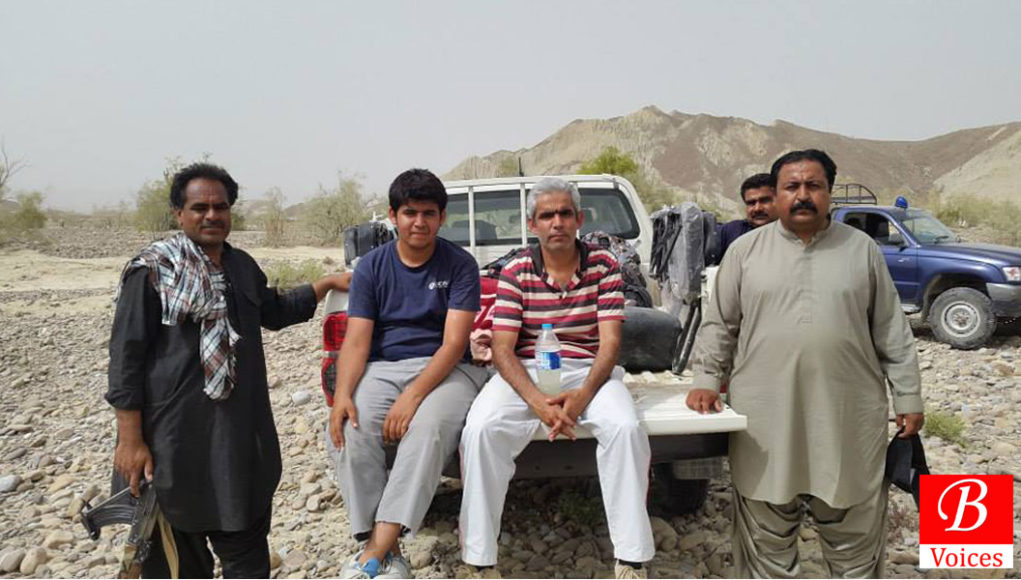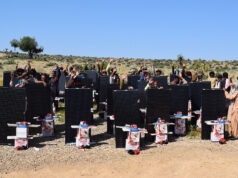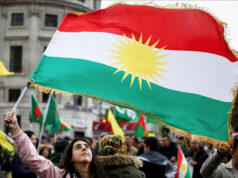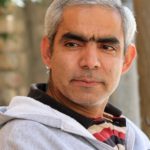 Aziz Ahmed Jamali
Aziz Ahmed Jamali
I kept listening to myths and stories about the far flung wildlife zones of Balochistan until I decided to experience it myself in April last year. Duroon is an over 15 kilometers long hill feature in Awaran district, Balochistan. Interesting to watch on Google Earth, and even more while walking there. For a three day-long expedition, we chose local friends to keep us company; while we also invited Makbool (Mac) and Zarnab from Karachi. Mac is an adventurer/filmmaker while Zarnab an amateur artist (essentially singer). My younger brother Feroz, a student at Karachi University, also tagged along to try his first ever long trek.
Read Also: Hailing Hingol on Feet and Jeep: Shirin Farhad to Hinglaj Mata
From Awaran, it was me along with District Forests Officer Abid and Mama Marri, an old man of 70, yet proving younger than many while trekking in the wilderness. A few armed guards of Levies Forces accompanied us per protocol (I was Awaran’s area administrator / Deputy Commissioner then.) In two vehicles we drove along the Ara Kaur stream off the Awaran–Bela Road in Jhaoo Tehsil. We bought a goat from Daleen Jah village for food that night, and reached our camping site after sunset.
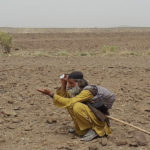
With the weather being dusty that night; it didn’t afford us enjoying full moonlight. Before sleeping amidst a battle against mosquitoes, we set our sole tent near an abandoned room which appeared to be a Wildlife Check Point in the recent past. Since anti-state insurgency had spread around Awaran, part of the wildlife protection job was self-assumed by Baloch militants in an attempt to overtake the government. This time, however, Forests & Wildlife Department officers accompanied us in an attempt to reassert their authority; and I endorsed the idea being a representative of the Pakistani State.
It dawned at six in the morning and we were all set to begin trekking by 7.30AM. Our beginning point was where the Duroon Kaur stream drains into Ara Kaur, which then joins the main body of the Hingol River further south. The first wildlife we saw was a multicolored, essentially green beetle sitting on a stone that lay across my feet incidentally. However, though we kept on for the next eight hours, we couldn’t spot much except a mad camel and the footprints of mountain goats.
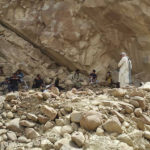
Duroon village is a day long excursion from Ara Kaur; with the better part being along Duroon Kaur. Another, longer camel trek existed but locals said that it was devoid of water; so we left it for the camels to decide and continued along the stream. After three hours we reached the most beautiful sight on Awarani soil: it was where the stream took to the shape of water falling down in a broad pond, round in shape with the color of water having turned green due to the depth and vegetation. Instantly it reminded me of Pir Ghaib of the Bolan Pass and of Pari Chashma in the hills above Harnai. All these spots have flowing water in a fall-plus-pond shape with floral vegetation adding more to their fairy-tale beauty. Mac assisted by Umar rushed to set the camera for clicks and videos; while I, Abid and Feroz took to enjoying the heavenly place for the short while we were there.
Our trek further was getting steeper; a 20 feet long rope was permanently fixed at a hard-to-hike spot for the convenience of travelers. Having climbed up that Pul-e-Sirat, we came across pools of water that we couldn’t resist jumping in. Since the day had already turned warmer, a cool bath was the best treat. Our local partners served us with hot & sweet tea to dispel any nasty after effects of cold water. Abid kept briefing us about the wildlife while Zarnab sang our favorite songs, thus enabling us to cherish the experience. We continued the long walk to our destination in the high hills.
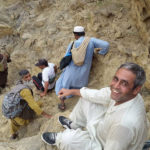
Having passed by a few dens of mountain goats (one could guess from the droppings and footmarks), we hiked up the treacherous turns to emerge in a long valley which seemed like the last part of the journey. That steep portion showed us quartz like stones, white and yellowish in color resembling marble. Some guessed that those were signs that an ocean existed here in the distant past; a couple of sea-shell fossils posed as evidence.
Daaru turned out as the most helpful company with us that day and night. Daaru was a Forest Department official, who’s eyes would speak without the man speaking himself; the strength of his gaze took one deep into the deprivation which engulfed the poor community atop the mountains. Duroon village had no approach road, no education or health facility and neither a mosque to boast a bit. While we took along tiredness with us, Daaru carried only weight – without a remorse or worry.
Passing by ripe wheat crops at its very entrance, and a mad camel just before, we reached the hilltop village of Duroon, situated at an altitude of 4500 feet above sea level. One would be surprised to observe the impressive agriculture in that isolated valley.
Tired of the eight-hour long walk, we removed our shoes and took refuge under a thatched roof; which afforded us the best shade ever. Our hosts had prepared a traditional meal for us: Baloch Sajji (roasted lamb) and a simple yet tasty curry to be devoured with bread. Black tea with sugar added more to the experience.
After that heavy and late lunch, a walk was essential and helpful. So we spread out around the village observing lifestyle. Youngsters were sitting and chatting only, least exposed to any modern sports. None of them knew who Shahid Afridi was; nor did they bother that their area administrator (Deputy Commissioner) had visited Duroon, a rare time in history. Further chats with people revealed that they knew the name of an old politician (Mir Majeed Bizenjo) and remembered a Levies official he used to send to Duroon.
Mac began with recording bits of the documentary with which he wanted to impress the world; it was an impressive community dwelling, so isolated from the rest of the world. They would treat injured animals by fastening their legs with dwarf Palm (Mazri) leaves. Camels were their sole mode of travel; only a couple of diesel engines had made their way into Duroon to be used for fetching water out of depths. The primitive housing consisted of either mud-made structures or thatched huts. Duroon seemed to have recently transformed from a hunter-gatherer community into an agrarian one.
Sitting on a nearby hilltop, we asked about visiting the highest spot of Duroon, at 5000 feet; but it was more than six hours on foot. Since we had spent half a day traveling on jeeps and a whole day on foot (leaving us one day for the return journey), it was a difficult decision to spare another day for a journey to the heights. Thus we decided to return the next day. We slept in blankets due to the cold weather.
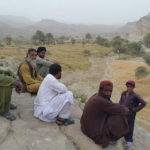
Around 7AM next morning we were served with fresh bread and hot tea and set foot to return via an alternate route which Daaru & Company warned was impossible for us to traverse. Locals of Duroon contended that the trek was steep and, coupled with non-availability of water en route, posed even greater risks than the one we came by last day. In our craze to explore more, we decided to give it a try. After a two hours ascending trek, we reached the steep descent point. The view was threatening yet thrilling – it was rightly called the Shak Pass (‘Shak’ means comb in Baloch, and the way down went in long zig-zags quite literally like the teeth of a comb).
Low hills around the Ara Kaur could be seen about 2000 feet down, all visible from a single gaze. For once we could not believe that we had to descend that distance, inching down all the way; but we did it amidst no other option. Zarnab removed his shirt, sang another ghazal and began to descend in a last-travel-of-life mode. Abid and Mama Marri kept hopping like mountain goats, Feroz made comprehensible gestures of taking-shit-out-of-something and I kept encouraging all for the next two hours. Asad and Mac were literally fastened with cloth bands to enable them to move ahead instead of returning, with two local men supporting.
We reached the next comfortable spot to gulp a cup of black tea contemplating how possibly we descended; it seemed more painful than Adam’s descent down from paradise. While the tea break went on, we also enjoyed following the brisk movement of a lizard, which was pure black & white. There we discussed as to how hard it was for the indigenous people to do that traverse; and explored options to build a trek more comfortable for the community. The advantage the Shak Pass offered that it was eight to ten hours shorter than the route via Duroon Kaur (on which camels took 18 hours from Duroon village to reach the nearest facility on Bela–Awaran road).
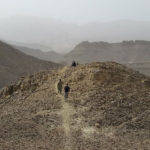
It took us half an hour to chalk out the plan, assess required implements and assign the project to Duroon’s community under able and experienced leadership. In little over an hour, we reached our vehicles parked along the Sorh Kaur, a tributary of the Larrandari/Ara stream; there we enjoyed another simple meal of rice with drinks and laughter.
Within the next 100 days, Mama Marri gave us the good news that an alternate track was ready; the Shak Pass was made traversable by camels and Duroon village accessible in eight hours from the main road; all made by their very own community. Costing us half a million rupees of district resources, that camel track was the best public service one could achieve for the poor people who dwelled in Awaran. I had promised the community that the government would help them with a school building in the future.
I was transferred from Awaran in August last year; yet pleasant news kept reaching me at Quetta for another couple of months. The camel track had not only facilitated patients or the small traders of Duroon, it had also made transportation of construction materials possible. Thus was built the first ever school building in the town, a strong structure constructed in line with seismic safety guidelines, which were prescribed by the government after the 2013 earthquake in the region.
Our craze to trek and touch the highest spots of Duroon hill feature and to watch ‘dozens of mountain goats’ still remains; hope to make it some other time.
Writer is an officer of Pakistan Administrative Services.
Share your comments!


